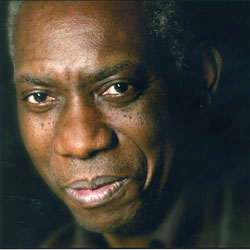These frantic blooms can hold their own
when it comes to metaphor & God.
Take any name or shade of irony, any flowery
indifference or stolen gratitude, & our eyes,
good or bad, still run up to this hue.
Take this woman sitting beside me,
a descendant of Hungarian Gypsies
born to teach horses to dance & eat sugar
from her hand, does she know beauty
couldn’t have protected her, that a poppy
tucked in her hair couldn’t have saved her
from those German storm troopers?
This frightens me. I see eyes peeping
through narrow slats of cattle cars
hurrying toward forever. I see “Jude”
& “Star of David” scribbled across a depot,
but she says, That’s the name of a soccer team,
baby. Red climbs the hills & descends,
hurrying out to the edge of a perfect view,
& then another, between white & violet.
It is a skirt or cape flung to the ground.
It is old denial worked into the soil.
It is a hungry new vanity that rises
& then runs up to our bleating train.
I am a black man, a poet, a bohemian,
& there isn’t a road my mind doesn’t travel.
I also have my cheap, one-way ticket
to Auschwitz & know of no street or footpath
death hasn’t taken. The poppies rush ahead,
up to a cardinal singing on barbed wire.
Notes on the Poem
Colour can be a potent symbolic or sensory component of the most memorable and affecting poetry. Colour associated with specific objects or beings can add layers of meaning that can in turn produce rich emotional resonances. However, if layered on too thickly, that deluge of highly charged colour can intimidate, overpower, muddy the intent of a piece. Yusef Komunyakaa uses colour and vividly coloured entities sparingly and, as a result, powerfully in this selection from his collection The Chameleon Couch. Not only does Komunyakaa use colour carefully in "Poppies," but he pragmatically hastens to deconstruct the usual associations with the colour and the internationally significant symbol of the flower by tackling it in the opening lines of the poem: These frantic blooms can hold their own when it comes to metaphor & God. While going on to grant that we'll still react to "this hue" regardless, he moves on to place the flower in the hair of a women under threat. Not only is the placement of the flower not expected - we think of it pinned solemnly to coats and lapels - but its seeming potency is immediately defused, as it doesn't save her. Komunyakaa moves swiftly from historical but still pervasive memories of horror to more recent and personal concerns and challenges, relating quite literally to colour. The red morphs from poppies to a cardinal - vibrant, passionate, singing defiantly, as vividly symbolizing life as well as death. The blazing red frames and continues to inflame an unflinchingly provocative poem.

When I started reading your poetry I had no expectations and was rather skeptical but I loved it….beautifully expressed.